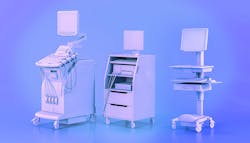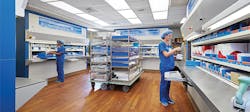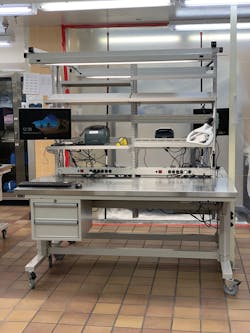Call them data and information sidekicks or even the defibrillator assisting the heartbeat of patient care, but workstations – mobile and stationary – really function as workhorses throughout the clinical and operational areas.
With computerized, digital electronic assistants, we’ve progressed a long way from the analog routine – pen, paper and clipboard with sticky notes. While the latter may have been equally as convenient and mobile on the front end, the process involved a bit more manual data entry on the back end, something its automated successor solved.
Even stationary workstations – areas designed and dedicated to the effective and efficient performance of certain tasks – represented an improvement over occupying some nook or space to complete an integral task.
Few can argue that smart phones serve as sort of an untethered mobile workstation, just shy of perhaps a “tricorder” on “Star Trek.” But the industry seems headed in that direction – from advanced computers built into desks and tables or flat screen monitors affixed to the wall either as art or mirrors to hand-held and wearable devices with monumental computing power.
Imagine redefining the concept of taking your workstation with you on your person in the form of a hand-held or wearable device or tapping on something festooned to the wall.
Does that future entice and excite clinicians and end users? Or do they prefer the comforting familiarity of convenience they have today?
Utility over futility
As today’s culture – business and consumer – strives to do more with less, it should come as no surprise that convenience leads the list of favorable attributes and features of today’s mobile and stationary workstations, as noted by a number of workstation supplier executives tuned in to customer demands. That includes access and mobility.
Yet, ergonomics, ease-of-use/user-friendliness (arguably a synonym for convenience) and, of course, cleaning, disinfecting and sterilizing against the backdrop of the COVID-19 pandemic, remain close in priority for the health and safety of clinicians and patients alike.
“Having access to critical data is of utmost importance,” Salus told Healthcare Purchasing News. “If it’s not with the clinician, it’s not convenient, nor accessible. It needs to be portable. And it goes without saying – COVID or no COVID – it needs to be clean.”
Salus stresses that InterMetro incorporates computers and the power to keep them mobile on its workstation platforms – including bedside, anesthesia, IV therapy, critical care and emergency overflow, among others. These carts also include Microban antimicrobial protection.
“Sterility, infection control and cleanliness have got to be the biggest priority above all other attributes,” insisted Ian Loper, Vice President, DSI. “Without full achievement, you have an unsafe working environment for both employees and the patients. Stainless steel work surfaces are the tried-and-true surface that enables full infection control, but to achieve full sterility, the employees must continue to wipe down their work surface before and after every shift.”
Workstation utility should be designed around clinician engagement with the patients, which can affect the patient experience and also the well-being and workflow of the clinician, according to Brian Hazelwood, Marketing Manager, Medical Division, Midmark.
“The use of mobile workstations to create a flexible workspace inside the patient care zone can greatly enhance patient engagement,” he noted. “This mobility allows physicians to work in the way they are most comfortable, whether that be seated, standing, mobile or stationary. Midmark workstations adjust in height – 23 inches to 49 inches – while offering tilt and rotation functionality that allows for a proper working position to be maintained without sacrificing eye contact with the patient. Mobile workstations designed to improve the caregiver-patient interaction enable organizations to easily bring digital information to the point of care without sacrificing workflow.”
Hazelwood also emphasizes the need for operational flexibility.
“The use of mobile or wall-mounted workstations can also bring devices – desktops, laptops and tablets – within arm’s reach, decreasing the need for caregivers to move within the space and maximizing engagement with patients,” he said. “All necessary data is accessible at the point of care and can be shared by caregivers. Digital and physical care interfaces are within the same work zone, and the movement of caregivers is minimized as constant contact with patients is maintained.”
Ergonomics reinforces flexibility, which benefits the end user as well as the healthcare organization, according to David Phillips, Marketing Manager, Hänel Storage Systems.
“Workstations should be the correct height so that employees no longer need to bend or squat to lift items from near the floor, extend or climb stepstools to reach items awkwardly stacked above, or make repetitive motions that are outside OSHA’s recommended ‘golden zone,’” he said. “It’s in a hospital’s best interests to keep its employees healthy. Any of these movements can result in a pulled muscle, strained back or slipped spinal disc, and when they occur on the job, the employer can be on the hook for financial compensation and rehabilitation that can last for months. A change in ergonomics can also mean a simpler design that’s much easier to use.”
“At their foundation, mobile workstations help caregivers save critical steps by carrying what they need most often to deliver patient care. They’re also designed for clinicians to easily access electronic medical records,” he said.
Some workstations are designed with a technology focus and not as much on the user experience and clinical workflows, forcing caregivers to adapt,” Torbett continued. “Too much emphasis on technology and healthcare software can make it more complicated and difficult to deliver care instead of making it easier. We listen closely to the pains and wishes of clinical users, IT and administrators. It’s about asking open-ended questions and using the right ways to uncover unmet needs and identify innovative ideas for a solution.”
Torbett cites one example of how Capsa installed a seven-inch glass touch screen on the front of its CareLink carts that served as an eye-opener for the company.
“We did research with nurses about what belongs in a screen,” he said. “If you had a screen like that embedded in the cart, what do you wish it did? What do you wish you could use your smartphone for in front of patients? It led to the development of a number of features, some of which we wouldn’t have necessarily even thought of. That was powerful for us.”
Flexibility filleted
Tapping clinician and end-user suggestions, manufacturers of mobile and stationary workstations have adapted and improved the products they offer but acknowledge further design and development efforts will yield the changes needed to remain lock-step with progress.
Such progress – incremental and beyond – starts with a fundamental understanding of the function of these products, according to Emma Naclerio, Mechanical Engineer, TouchPoint Medical.
“While users of [workstations on wheels] may have similar workflows, no two WoWs are used exactly the same,” she told HPN. “At the end of the day, this is the user’s ‘desk,’ and the user should be empowered to customize it as they see fit to do their job. This can be achieved through user/ergonomic settings that automatically apply when the user logs in with their RFID badge, bins/hooks/shelves that the user can swap/rearrange to suit their work, or smaller touches like spaces for writing notes or applying identifying decals and signage.”
Capsa’s Torbett links ergonomics into the equation, akin to electronic settings geared to individual drivers of a car.
“Workstations with a lot of adjustability and easy maneuverability that adapt to users’ needs is critical to their health and satisfaction,” he observed. “For example, we introduced user stored preferences for standing and seated heights for a workstation, similar to saving user settings in car seats. When caregivers save their preferences, they transfer to every other workstation through our fleet management system. We also introduced a trigger-operated steer assist feature, designed to reduce strain in users’ shoulders as they push a workstation through hallways.”
User “personalization” and adaptation are becoming key differentiators, according to Bradley Carlson, Product Manager, Point of Care Solutions, TouchPoint Medical. “In addition, things like an inductive phone/device charger on the work surface or multiple color section availability are nice touches. With the trend towards non-powered and ‘lightly’ powered carts rapidly growing, if some of these personal touches can be incorporated into much lighter weight form factor, then that would be a home run – for documentation carts.”
Sarah Leitz, Director, Product Marketing, Altus Industries, urges seamless transitions between devices as a key benefit.
“Make it easy and simple to move back and forth between mobile and desktop applications,” she said. “Mobile is great for many use cases, but heavy documentation on a mobile device is difficult and frustrating. Being able to easily go back and forth between the two is critical to workflow and ease of use.”
Leitz indicates that her company currently is developing with a manufacturing partner – ACS MediHealth – an attachment to the cart that would allow the clinician or end user to dock a mobile device and use it to run software, such as electronic health records – on a larger screen.
The necessary functional attribute that should define workstation design for the near future is integration, according to InterMetro’s Salus.
“More and more procedures are happening at the patient bedside, rather than moving patients to the service,” he noted. “This requires the clinicians to bring their tools and supplies to the patient. The design of the workstation needs to address mobility, portability and integration. The clinicians need to easily transport the workstation with them to the patient but also need the workstation to accommodate their supplies, medications, tools and technology required for the procedure. It makes for a unique solution that delivers these required functions that doesn’t sacrifice [one] feature to provide another.”
Midmark’s Hazelwood concurs with the drive for integration to push workstation development.
“As the practice of healthcare evolves, technology will continue to play a larger role in the exam room and in how physicians and caregivers interact with patients,” he noted. “A fully connected digital ecosystem where point-of-care processes, equipment and caregivers are integrated will help enhance the care delivery experience. Workstations should be intuitive for the user, support the deployment of technology at the point of care, and properly support the provider-patient interaction and the clinical workflow. Integration of technology – and as a result, proper diagnostic readings – are important for improving patient outcomes. Without proper planning and the right equipment, integration of technologies such as EMRs and tablets could negatively impact the overall efficiency of the care process.”
But the current COVID-19 pandemic should motivate additional design changes that may include surface features.
“With infection prevention and sterility as the priority, 10 years from now I would assume every workstation within an SPD will be entirely stainless-steel except for the desired accessories,” Loper envisioned. “There might be some small incremental upgrades to the bells and whistles attached to the workstation but the movement going forward will continue to be towards all stainless-steel materials to help increase sterility within the department.”
Hänel’s Phillips acknowledges that providers and suppliers can learn valuable lessons from the pandemic – one of which may involve more automation.
“One improvement to stationary workstation design should be that they’re easily disinfected,” he said. “If COVID-19 has taught us anything, it’s the need to clean and disinfect surfaces that are frequently touched. In storage areas containing a myriad of shelves, those shelves are touched on a regular basis, presenting a greater chance of exposure to pathogens, and therefore a greater risk to health. Efforts to contain potential disease transmission on so many high-touch surfaces could be better done by decreasing human exposure to these surfaces. Automated vertical carousels feature a single stainless steel worktable that is easy to clean and disinfect, rather than multiple surfaces that are more difficult to address. Cleaning can be done as often as possible, and chemical disinfectants never come into contact with the sterile supplies stored within the carousel.”











